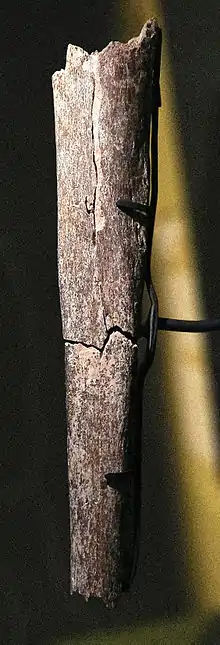Boxgrove Man
Boxgrove Man is a fossil thought to belong to either a female or male Homo heidelbergensis, an extinct relative of modern humans (Homo sapiens), and dated to roughly half a million years old. The fossil was discovered in 1993 in Boxgrove, West Sussex, near the south coast of England, by archaeologist Mark Roberts and his team of the Institute of Archeology at University College London.[1] Only two pieces of the tibia (shinbone) and two teeth were found, so little is known about the characteristics of the human to whom the fossil belonged. It may be that this was a strongly-built woman, the gender cannot be determined and the species was robust in adaptation to the cold. The subject was about 40 years old, 1.8 m (5 foot 11 inches) tall, and weighed roughly 14 stone (200 lb; 89 kg). It is thought to be the oldest human fossil ever discovered in Britain.[2]

Boxgrove's life
This particular fossil of an approximately 40-year-old dates back to the Middle Pleistocene era (ca. 500 ka BP).[3] The tibia of the subject is very sturdy indicating that it belonged to a strongly-built adult around 5 feet 11 inches (180 cm) tall, weighing about 14 stone (89 kg).[4][5] The exceptional structural strength suggests a cold-adapted body with proportions paralleling those of the Neanderthals.[6] Archaeological evidence indicates that these early humans had the ability to hunt or at least scavenge with stone tools as the team discovered hundreds of Acheulean flint tools at the site.[7] The two teeth found show scratches, suggesting an eating technique in which food was cut with a tool whilst gripped between the jaws.[2]
Wildlife found at the site
Also present at the site where the human fossil was discovered, were the remains of now extinct species of rhinoceros, bears, and voles.[8] It is most likely that H. heidelbergensis hunted these animals for sustenance with the aid of the stone tools also discovered at this site. There is clear evidence on the animal remains that they were butchered, but it cannot be proven that the species whose fossil was found in association with them hunted these animals or scavenged them. Teeth marks on the tibia fossil may be evidence that he or she was scavenged as well, either by cannibalism or scavenging by another animal.[9]
See also
References
- Hawkes, Nigel (May 24, 1994). Rise of Boxgrove Man.
- Neil Oliver (2012). A History of Ancient Britain. United Kingdom: W&N. p. 480. ISBN 978-0753828861.
- Streeter et al. 2001, Margret (2001). "Histomorphometric age assessment of the Boxgrove 1 tibial diaphysis". Journal of Human Evolution. 40 (4): 331–338. doi:10.1006/jhev.2001.0460. PMID 11312585.
- "BBC - Science & Nature - The evolution of man". www.bbc.co.uk. Retrieved 2018-01-30.
- "ARCHAEOLOGY: Boxgrove Man reveals his Stone Age-old secrets". The Independent. 1994-06-22. Retrieved 2018-01-30.
- Stringer, C.B.; Trinkaus, E.; Roberts, M.B. (May 1998). "The Middle Pleistocene human tibia from Boxgrove". Journal of Human Evolution. 34 (5): 509–547. doi:10.1006/jhev.1998.0215. PMID 9614636.
- Stout, Dietrich; Apel, Jan; Commander, Julia; Roberts, Mark (2014-01-01). "Late Acheulean technology and cognition at Boxgrove, UK". Journal of Archaeological Science. 41: 576–590. doi:10.1016/j.jas.2013.10.001. ISSN 0305-4403.
- "500000 BC - Boxgrove - Current Archaeology". Current Archaeology. 2007-05-24. Retrieved 2018-01-30.
- A History of Britain, Richard Dargie (2007), p. 8–9